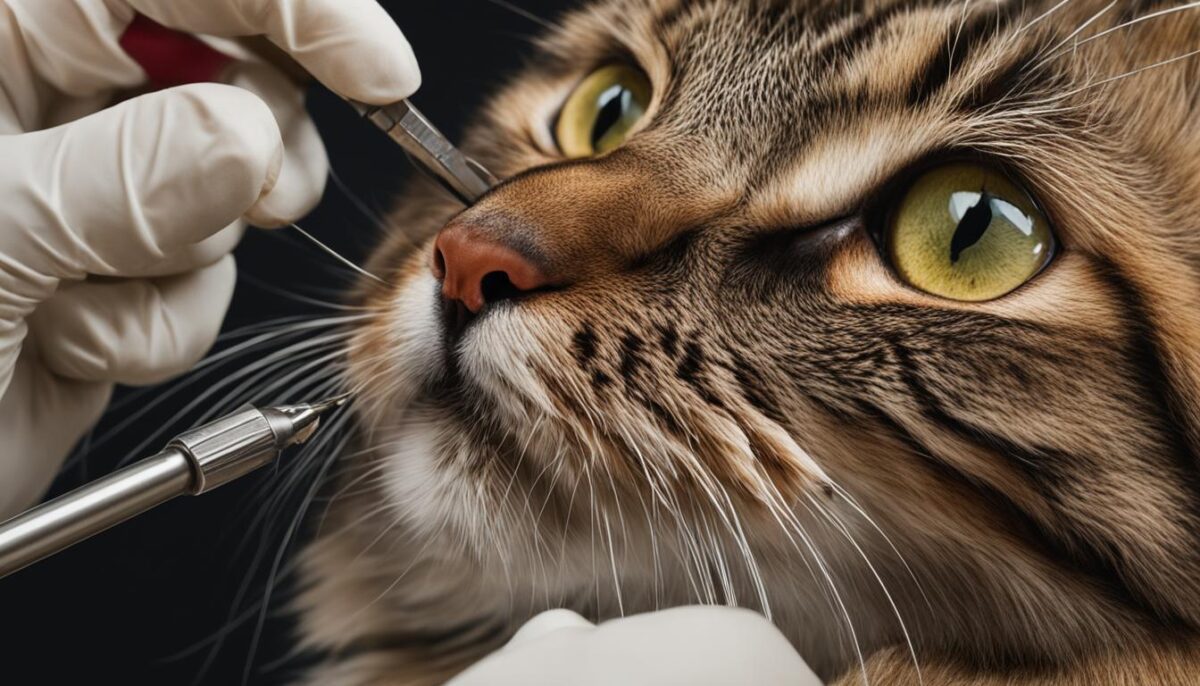If you’ve noticed your cat scratching more than usual or spots where fur is missing, it’s possible they could have feline mange. Mange in cats is a skin issue caused by tiny bugs called mites. Sometimes these pests are hard to spot, but they can create big problems. Cats that spend time outside or those not in tip-top shape are more at risk. But don’t worry, there’s mange treatment and prevention that can help your furry friend feel better.
Paying attention to mange symptoms is important. These include lots of scratching or areas where the fur has gone away. The good news is, a trip to the vet can lead to a solution. They know all about mange causes, risk factors, and how to stop it. Remember, healthy and happy indoor life can make a big difference in keeping your cat safe from mange.
Key Takeaways
- Watch for signs of itching or missing fur in your cat.
- Outdoor cats and those with health issues have a higher mange risk.
- A vet can diagnose and suggest the right mange treatment.
- Keeping your cat indoors helps with mange prevention.
- Good care is key to a mange-free life for your pet.
Understanding Mange in Felines: A Common Parasitic Skin Disease
Hey there! Have you ever heard of feline mange? It’s a sneaky skin problem for cats that’s caused by tiny bugs called mange mites. These little pests can live on your furry friend’s skin or even burrow into it, which can make your cat feel really itchy.
Now, not all mites are bad news. Some are just part of a cat’s normal bunch of microscopic buddies. But when these mites start to party too hard, they can make your cat’s skin angry and even cause hair to fall out. This is especially true if your cat isn’t feeling 100% to begin with. If you see your cat scratching their ears, face, and legs more than usual, it might be a sign that something is up.
What is Mange and How Does It Affect Your Cat?
Mange is like an uninvited guest that crash-lands on your cat’s skin and causes a bunch of trouble. Skin conditions can get pretty serious if mites like Demodex decide to go wild. These parasites take advantage of cats with weaker immune systems and can lead to lots of scratching and hair loss. Because these mites are so tiny, you can’t see them with just your eyes, so this is a mystery a vet needs to help solve.
Types of Mange That Your Cat May Encounter
Alright, let’s talk about the different types of mange that might bug your cat. Each type comes from a different kind of mite, so it’s like a not-so-fun zoo of parasitic infestations. Here’s a quick look:
- Sarcoptes scabei: This mite can make your cat very itchy, like “can’t-stop-scratching” itchy.
- Notedres cati: These guys are cousins to Sarcoptes and they like to hang out on your cat’s face.
- Demodex cati and Demodex gatoi: If your cat has one of these, it might start losing patches of fur.
- Cheyletiella mites: Also known as “walking dandruff,” these mites can look like tiny moving specks.
- Otodectes cynotis: These mites party in your cat’s ears, leading to head shaking and ear scratching.
- Trombiculosis: Caused by the larvae of chigger mites, this one gives your cat itchy red spots.
Your cat counts on you to keep an eye out for these itchy invaders. If you see signs of skin conditions or lots of scratching, it’s time to visit the vet. They’ll know how to help your feline buddy get back to their happy, playful self!
Can Cats Get Mange?
Have you ever heard about feline mange? It’s when tiny bugs called mites make a cat’s skin itchy and sore. All cats can get mange, no matter their age or type. But, some cats are more likely to catch it. For instance, older cats or cats that aren’t feeling well mange susceptibility is higher because they can’t fight off the mites as easily.
Even cats that live inside away from other animals can get mange. Yes, that’s right! Indoor cats can also face mange exposure, though it’s less common. Cats that already have health problems face more feline mange risk. Their little bodies struggle more to keep those pesky mites away.
- Indoor cats: They’re mostly safe but can still get mange.
- Older cats: They need to be extra careful. Their immune systems aren’t as strong.
- Cats with health issues: They have a tough time fighting off mites.
It’s important to keep our cat buddies safe. If you see a cat scratching a lot or if they have patchy fur, they might need a vet to check for mange. Remember, all cats can catch mange, but we can help them stay happy and healthy!
Recognizing the Signs: Symptoms of Mange in Cats
If your furry friend is always scratching, they might be trying to tell you something. It could be a sign that they have mange. Mange is a skin problem that can make kitties feel really itchy and not at ease.
Feline restlessness and being an itchy cat are common symptoms to watch for. Your cat may be unable to settle down comfortably, always moving around, trying to scratch that bothersome itch.
Restlessness and Intense Itching: Key Indicators of Mange
Your cat might scratch, nibble, or lick their fur a bunch. This can hurt their skin and might make their fur fall out. These mange signs in cats are like a big, flashing neon sign that says, “Hey, something’s not right here!”
Patchy Hair Loss and Skin Issues Resulting from Mange
If you see spots where your cat’s fur is missing, especially by their ears and face, that’s another clue. This could be mange patchy hair loss or feline alopecia. Their skin might look red, bumpy, or like it has dandruff. These are signs their skin is angry and needs help—what adults call skin inflammation.
| Signs of Mange | What You’ll See | How Your Cat Might Feel |
|---|---|---|
| Itchy Behavior | Scratching a lot | Uncomfortable and restless |
| Patchy Hair Loss | Bald spots, especially around the head | Maybe embarrassed, more itchy |
| Skin Changes | Redness, bumps, or “crusts” on skin | Sore, possibly painful |
If your cat shows these signs, they need to see a vet. The vet can make sure if it’s mange and help your cat feel better.
Fighting the Mite Infestation: Diagnosis and Treatment
When your cat starts to scratch itself more than usual, it’s time to check if those itchy pests called mites have paid a visit. Your friend in white, the veterinarian, plays a big part in finding out what’s bugging your kitty. They have special tools and know-how to spot the sneaky mites that might not want to show up on regular tests.
The Crucial Role of a Veterinarian in Diagnosing Mange
Imagine your cat as a detective and the vet as their trusty partner. Together, they go on a mission to find clues under the fur. The vet takes a little sample from your cat’s skin, something called a skin scraping test. They take a close look at it, using something like a super-powerful mini telescope called a microscope. This is the moment of truth, where they might see the mites causing all that itchiness.
Sometimes, the mites play hide and seek and don’t show up. But don’t worry, the vet’s got backup plans. They think about what they see on your cat and what they know from books and experience to come up with the best way to help. The first step in a mange diagnosis is getting those clues, and no one’s better at that than your vet.
Treatment Options: From Topical Medications to Injectables
Once the mites have been caught red-handed, or red-legged, it’s time to send them packing. Your vet has a suitcase full of tools to treat mange. They might send home some special lotions or topical medications that you rub right into your cat’s skin. They’re like magic creams that tell mites to scram!
If your cat has a bit of a tough time with mites, the vet might suggest some stronger help like injectable therapies. Think of them as extra muscle to show mites the door. And for bath time, they have something called mange shampoos. It’s like giving your cat a spa day that also tells bugs bye-bye.
If your cat’s skin is as grumpy as a lion with a thorn in its paw, the vet might give some anti-inflammatory medications to soothe the roar. That way, your cat’s skin can heal without doing an itchy dance all day and night.
Remember, whether it’s a potion, shot, or bubble bath, your vet’s got your cat’s back when it comes to fighting off those mite villains!
Prevention Strategies to Keep Your Cat Mange-Free
Wouldn’t you like to know how to keep your furry friend happy and itch-free? Let’s talk about mange prevention tips to make sure your kitty stays healthy. Even if your cat enjoys cozying up indoors, it’s important to take steps for indoor cat safety and feline mange protection.
Routine veterinarian care is your best friend in the fight against mange. A vet will give your cat check-ups to catch any sneaky mites before they cause trouble.
The Importance of Indoor Environments and Regular Vet Visits
Keeping your cat inside is one of the best ways to stop mange. Inside, it’s easier to control what your cat touches and meets, which means fewer chances of mite attacks. Make your home a safe playground for your kitty!
Don’t forget to schedule regular check-ins with the vet. They are like detectives looking for clues to make sure your cat stays healthy. They can spot mange from a mile away and give you the best mange preventatives.
Recommended Parasite Preventatives and Their Effectiveness
Want to know about some super-hero medicines? Here are a few your vet might suggest to keep those pesky mites at bay:
- Revolution – It’s a strong protector against many baddies, including fleas, heartworm, and of course, mange mites.
- Advantage Multi – Not only does it fight worms and fleas, but it also puts up a great fight against our tiny enemies, the mites.
- Bravecto – If your cat doesn’t like medicine often, this one’s great because it lasts a long time.
These anti-parasite medications can help keep your cat free from not just mange, but also other creepy-crawlies. It’s like giving them a super suit to stay healthy and strong!
Taking care of your furry friend might seem like a big job, but with these tips, you’re sure to do great. Keeping your cat happy and mange-free is all about loving them and taking the right steps. Now, go on and give your kitty some extra cuddles today!
Conclusion
So, what have we learned about keeping our furry friends comfortable and itch-free? To wrap up, mange is a skin trouble that can bother your cat, but it’s not unbeatable. Those tiny bugs called mites are what start mange, but you’ve got the power to help your cat fight back. With care from your vet, and by keeping your kitty inside, there’s a really good chance your cat will bounce back to being their playful, cuddly self.
Remember, giving your cat healthy food, clean toys and cozy blankets, and using the right medicine are all ways to keep mange away. Always keep a close eye on your pet for any signs that they’re itching too much or losing hair, and chat with your vet if something seems not quite right. By doing these things, you’re taking big steps in mange management for the health and happiness of your cat.
It’s all about making sure our pets are living their best lives. By understanding how to prevent and treat mange, you’re helping to ensure your cat remains a happy, healthy pet. Mange doesn’t have to be scary, especially when you know how to tackle it. Keep loving and looking after your furry buddy, and they’ll thank you with purrs and cuddles!
FAQ
What exactly is feline mange and how can it impact my cat?
Feline mange is a skin condition caused by tiny parasitic mites. These mites can cause intense itching, skin irritation, and hair loss for your furry friend.
Are there different types of mange that could affect my cat?
Yes, there are various types of mange in cats, including those caused by Sarcoptes scabiei, Notedres cati, Demodex cati, Demodex gatoi, Cheyletiella mites, Otodectes cynotis, and mites that lead to Trombiculosis.
Is my cat at risk for contracting mange?
All cats have some risk, especially if they spend time outdoors or have compromised immune systems. However, regularly scheduled vet visits and good preventative care can greatly reduce their risk.
What are the telltale signs of mange in cats I should look for?
Keep an eye out for signs of restlessness, intense itching, patchy hair loss, skin inflammation, or scaly and crusted skin, as these could all indicate the presence of mange.
How do veterinarians diagnose mange in cats?
Vets generally perform a skin scraping test and examine the sample under a microscope to detect the presence of mites. In some cases, they might diagnose based on symptoms and response to treatment if mites aren’t easily found.
What treatments are available for cats diagnosed with mange?
Treatment options include topical medications, injectable therapies, special medicated shampoos, and sometimes, anti-inflammatory medications to relieve discomfort. Your vet will prescribe the best treatment plan for your cat’s specific type of mange.
How can I prevent my cat from getting mange?
Keeping your cat indoors, providing a clean and sanitary environment, ensuring good nutrition, regular vet check-ups, and using veterinarian-recommended anti-parasite medications are effective ways to prevent mange.
Which preventive products protect against mites that cause mange?
Products like Revolution, Advantage Multi, Revolution Plus, and Bravecto have been shown to be effective in protecting cats from mites that can cause mange. Always consult your vet to choose the best option for your cat.


